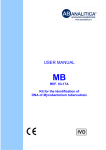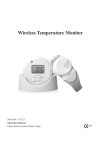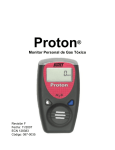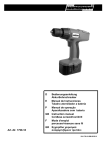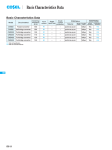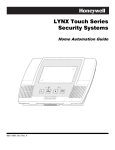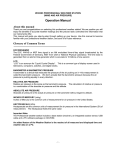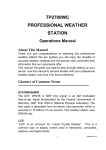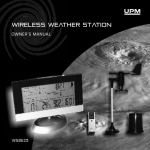Download VOLUNTEER USER GUIDE & CODE OF PRACTICE
Transcript
Contact Details VOLUNTEER USER GUIDE & CODE OF PRACTICE Important telephone numbers: Community SpeedAware Support Team (Chris Fossey or Poonam Pathania) Office phone: Mobile: 01926 418612 07824 867062 Lines open: 09.00 – 16.00 hours Email: [email protected] Address: Community SpeedAware Road Safety Education WCC PO Box 43 Warwick CV34 4SX Defect on the highway: 01926 412515 Police non-emergency: 01926 415000 Emergency: 999 or 112 15. Return details: Date: / Location: / Time: Example Data Sheet to record vehicle speeds Cover Contents Page 2: Introduction Location Site Approval & Use Date Loan Agreement Time Purpose of Community SpeedAware scheme Page 3: Using manual traffic speed data Page 4: Site clothing Setting up the Smiley SID sign Pages 5 - 10: Assembling the sign. Page 10: Looking after the equipment Equipment Check List Page 11: Positioning and operating the sign Page 12: Supervising the equipment Parking your vehicle safely Abuse from the Public Page 13: Insurance and Liability Cover Returning the equipment Page 14: Example Data Sheet to record vehicle speeds Page 15: Contact Details 1. 08.00 – 08.30 08.31 – 09.00 09.01 09.30 09.31 – 10.00 10.01 – 10.30 10.31 – 11.00 11.01 – 11.30 11.31 – 12.00 12.01 – 13.30 13.31 – 14.00 14.01 – 14.30 14.31 – 15.00 15.01 – 15.30 15.31 – 16.00 16.01 – 16.30 16.31 – 17.00 17.01 – 17.30 17.31 – 18.00 Speed 25-30mph Speed Limit (delete as appropriate) 20mph 30mph 40mph 31-35mph 36-40mph 41-45mph 46mph + Insurance and Liability CoverCover As a volunteer trained and working under the guidance of Warwickshire County Council, you are covered by the Council’s public liability and personal accident insurance when borrowing and operating our equipment. Public liability insurance covers injury to third parties arising out of operation of the flashing sign. Personal accident insurance covers death or very serious bodily injury and damage to personal effects when such damage arises as a result of bodily injury. The flashing SID sign is not insured. However, Warwickshire County Council strongly recommends where possible that you also have your own public liability and indemnity insurance to cover you in case any such incidents occur. Introduction This guide and code of practice MUST be followed at all times for your own safety and protection. Failure to do so could invalidate any public liability insurance cover provided by Warwickshire County Council and you will be liable for any misdemeanour that arises from non-compliance. It will also result in any future loan of our equipment being refused. Warwickshire County Council’s Road Safety Team will monitor SpeedAware activity on a regular basis. Site Approval & Use Community SpeedAware can only operate on roads with a speed limit of 40mph or less. A member of the Road Safety Team will assess the site(s) you have requested. You must only use the agreed site(s). Any subsequent sites must have the approval of the Road Safety Team. Loan Agreement Returning the equipment During the training session, a collection date will be agreed and written on the front page of this leaflet. Please ensure that you keep to the equipment appointment or call the Road Safety Team on: 01926 418612 if you will be late or need to reschedule. Please provide as much notice as possible. 13. You must have read and signed the equipment Loan Agreement before using the equipment. The Agreement must be signed by the head of the group/organisation e.g. Chair of the Parish Council. We will need to verify the name and address of all volunteers and therefore request sight of photographic ID. Purpose of Community SpeedAware scheme Community SpeedAware is an educational tool to inform drivers of their speed in relation to the posted speed limit. Whilst in use, data may be manually recorded, however the purpose of the data must be anonymous and should only be used to provide an overall picture of the speed of vehicles travelling though a community. For accuracy when undertaking manual surveying, only record the first speed flashed at a vehicle. You must not use the equipment to conduct Community Speed Watch type activities whereby you record vehicle information i.e. number plates, for the purpose of identifying drivers in order 2. to administer a consequence i.e. send warning letters. Warwickshire Police already support a Community Speed Watch campaign where volunteers can use type approved speed guns for this application (organised through Community Forums). Using manual traffic speed data The scheme’s main aim is to support communities who are proactive about speed management in their local area. Therefore it is up to the group as a community to decide what to do with any data manually collected from the sign. If your data repeatedly shows that a significant amount of vehicles are exceeding the speed limit, there are 3 further options available to you: Community Speed Watch - volunteer based speed camera scheme, whereby Warwickshire Police may write to offending motorists caught speeding. SpeedAware Package - a fee based scheme which can provide up to 2 weeks dedicated SpeedAware activity including temporary fixed flashing signs and does not require any volunteers. Local Police enforcement - for any enforcement activity, please contact your Safer Neighbourhoods Policing Teams. You may wish to include any data recorded when requesting further Police assistance. For further SpeedAware work, please contact Warwickshire County Council’s Road Safety Team. Supervising the equipment You must remain within sight of the flashing sign at all times to provide security. The equipment is not insured for theft or damage, therefore any loss may result in the entire scheme being cancelled. Parking your vehicle safely You must park your vehicle in a safe and legal place away from the flashing sign. This should be off the road that is being monitored and in a place where access, free flowing traffic and pedestrians will not be impeded. If this is a private driveway or field entrance, ensure you have permission of the owner before parking there. This guidance also applies when offloading and picking up the sign whilst setting up. Abuse from the Public If you are approached by a member of the public, remain calm and rational. Do not get involved in any discussions or arguments. Hand them a copy of the Community SpeedAware flyer provided by the County Council which explains what the flashing sign is for and who to contact if they are concerned. You must not distract or make gestures to drivers. Always walk away from a troubled situation. Head for a place of safety e.g. a public building or your car (lock doors). As part of the scheme conditions, it is essential to carry a mobile phone. Store any emergency numbers in the phone’s memory so that they are readily to hand. 3. Please report any incidents immediately, e.g. verbal or physical abuse, to the Road Safety Team on: 01926 418612. 12. Positioning and operating the sign Do not step into the road under any circumstances. Make sure that the sign can be seen clearly and in plenty of time by approaching drivers. The flashing sign should be no closer than 100m from the speed limit entry sign to give drivers time to respond. The flashing sign should be positioned no less than 0.5m (2ft) from the kerb on a flat, stable and solid surface. Do not erect the flashing sign near parked vehicles, skips, road works or other obstacles. Do not erect the flashing sign on private property. Ensure that the flashing sign does not cause an obstruction e.g. blocking any access points or footpaths (1.2m (4ft) minimum clearance on footpaths required). Note on driveways – Only set up the flashing sign on a drive way if you have permission from the owner and it is not blocking access. Community SpeedAware must only be operated in daylight hours. Community SpeedAware must not be operated during bad weather, i.e. rain, fog, icy conditions or high winds. Recharge the flashing sign after each operation using a domestic mains power supply. Always ensure that the sign is securely stored when not in use and do not leave the equipment in a vehicle where it is clearly visible. 11. Site clothing The Road Safety Unit will supply high visibility jackets which must be worn when working on site. Failure to wear this protective clothing will lead to the scheme being withdrawn from use. Whilst on site we recommend the use of suitable footwear with good tread and clothing appropriate for the weather. Always wear the high visibility jacket over a coat and not under it, should the weather worsen. Setting up the Smiley SID sign Only those Volunteers who have received training may assemble or take down the sign (SID). The SID unit must always be assembled, operated and disassembled by a minimum of 2 trained volunteers. The SID unit can only Be used on stable, even ground such as pavements or a dry flat grass verge. 4. Assembling the sign. 11. System will now go into ‘self test’. Ensure that the sign is stable and that unit will not be blown over in high wind. Assess whether the unit is being activated correctly. The sign is heavy and should always be carried and erected by a minimum of 2 people. 1. Loosen large thumbscrew on tripod. If you have a collapsible SLOW DOWN sign, place this 12. approximately 100m in front of the flashing sign. 13. We strongly advise using the supplied securing straps to tie the the sign to existing street furniture for added stability. 2. 14. To dismantle the sign, follow the instructions in reverse. Looking after the equipment Extend tripod pole by pulling the top of the pole and ensure legs are as wide as possible. Please ensure after every deployment that you have all the equipment. If the equipment is lost, stolen or broken we will have to either restrict the use of or cancel the scheme. Equipment Check List 5. High visibility jackets. Collapsible sign. Flashing sign unit. Tripod. Face plate and 2 thumbscrews & dongle. Securing straps. 10. 9. Secure the 2 thumbscrews into the bottom of the face plate. 3. Extend the pole at the top of the tripod and place the securing pin into the lowest available hole. It is advisable to have the pole as low as possible for improved stability. 4. Tighten large thumbscrew. 10. Unscrew the dust cap underneath the unit (from the rear right hand side) and place dongle into hole. Turn dongle screw to tighten. Take care to turn top section of dongle otherwise if will fall apart! 9. 6. 5. 6. Lift front of case off. Lift unit onto pole. You may need to loosen the three thumbscrews on back of the unit – take care though – if too lose unit will fall onto ground. 7. 7. Tighten thumbscrews. (When dismantling the unit care should be taken not to loosen screws too much). Unit pictured has 3 thumbturns, new versions have just 1. 8. Rotate the sign and ensure one of the tripod legs is facing forward. Hook over metal face plate over the unit. 8. 5. 6. Lift front of case off. Lift unit onto pole. You may need to loosen the three thumbscrews on back of the unit – take care though – if too lose unit will fall onto ground. 7. 7. Tighten thumbscrews. (When dismantling the unit care should be taken not to loosen screws too much). Unit pictured has 3 thumbturns, new versions have just 1. 8. Rotate the sign and ensure one of the tripod legs is facing forward. Hook over metal face plate over the unit. 8. 9. Secure the 2 thumbscrews into the bottom of the face plate. 3. Extend the pole at the top of the tripod and place the securing pin into the lowest available hole. It is advisable to have the pole as low as possible for improved stability. 4. Tighten large thumbscrew. 10. Unscrew the dust cap underneath the unit (from the rear right hand side) and place dongle into hole. Turn dongle screw to tighten. Take care to turn top section of dongle otherwise if will fall apart! 9. 6. Assembling the sign. 11. System will now go into ‘self test’. Ensure that the sign is stable and that unit will not be blown over in high wind. Assess whether the unit is being activated correctly. The sign is heavy and should always be carried and erected by a minimum of 2 people. 1. Loosen large thumbscrew on tripod. If you have a collapsible SLOW DOWN sign, place this 12. approximately 100m in front of the flashing sign. 13. We strongly advise using the supplied securing straps to tie the the sign to existing street furniture for added stability. 2. 14. To dismantle the sign, follow the instructions in reverse. Looking after the equipment Extend tripod pole by pulling the top of the pole and ensure legs are as wide as possible. Please ensure after every deployment that you have all the equipment. If the equipment is lost, stolen or broken we will have to either restrict the use of or cancel the scheme. Equipment Check List 5. High visibility jackets. Collapsible sign. Flashing sign unit. Tripod. Face plate and 2 thumbscrews & dongle. Securing straps. 10. Positioning and operating the sign Do not step into the road under any circumstances. Make sure that the sign can be seen clearly and in plenty of time by approaching drivers. The flashing sign should be no closer than 100m from the speed limit entry sign to give drivers time to respond. The flashing sign should be positioned no less than 0.5m (2ft) from the kerb on a flat, stable and solid surface. Do not erect the flashing sign near parked vehicles, skips, road works or other obstacles. Do not erect the flashing sign on private property. Ensure that the flashing sign does not cause an obstruction e.g. blocking any access points or footpaths (1.2m (4ft) minimum clearance on footpaths required). Note on driveways – Only set up the flashing sign on a drive way if you have permission from the owner and it is not blocking access. Community SpeedAware must only be operated in daylight hours. Community SpeedAware must not be operated during bad weather, i.e. rain, fog, icy conditions or high winds. Recharge the flashing sign after each operation using a domestic mains power supply. Always ensure that the sign is securely stored when not in use and do not leave the equipment in a vehicle where it is clearly visible. 11. Site clothing The Road Safety Unit will supply high visibility jackets which must be worn when working on site. Failure to wear this protective clothing will lead to the scheme being withdrawn from use. Whilst on site we recommend the use of suitable footwear with good tread and clothing appropriate for the weather. Always wear the high visibility jacket over a coat and not under it, should the weather worsen. Setting up the Smiley SID sign Only those Volunteers who have received training may assemble or take down the sign (SID). The SID unit must always be assembled, operated and disassembled by a minimum of 2 trained volunteers. The SID unit can only Be used on stable, even ground such as pavements or a dry flat grass verge. 4. to administer a consequence i.e. send warning letters. Warwickshire Police already support a Community Speed Watch campaign where volunteers can use type approved speed guns for this application (organised through Community Forums). Using manual traffic speed data The scheme’s main aim is to support communities who are proactive about speed management in their local area. Therefore it is up to the group as a community to decide what to do with any data manually collected from the sign. If your data repeatedly shows that a significant amount of vehicles are exceeding the speed limit, there are 3 further options available to you: Community Speed Watch - volunteer based speed camera scheme, whereby Warwickshire Police may write to offending motorists caught speeding. SpeedAware Package - a fee based scheme which can provide up to 2 weeks dedicated SpeedAware activity including temporary fixed flashing signs and does not require any volunteers. Local Police enforcement - for any enforcement activity, please contact your Safer Neighbourhoods Policing Teams. You may wish to include any data recorded when requesting further Police assistance. For further SpeedAware work, please contact Warwickshire County Council’s Road Safety Team. Supervising the equipment You must remain within sight of the flashing sign at all times to provide security. The equipment is not insured for theft or damage, therefore any loss may result in the entire scheme being cancelled. Parking your vehicle safely You must park your vehicle in a safe and legal place away from the flashing sign. This should be off the road that is being monitored and in a place where access, free flowing traffic and pedestrians will not be impeded. If this is a private driveway or field entrance, ensure you have permission of the owner before parking there. This guidance also applies when offloading and picking up the sign whilst setting up. Abuse from the Public If you are approached by a member of the public, remain calm and rational. Do not get involved in any discussions or arguments. Hand them a copy of the Community SpeedAware flyer provided by the County Council which explains what the flashing sign is for and who to contact if they are concerned. You must not distract or make gestures to drivers. Always walk away from a troubled situation. Head for a place of safety e.g. a public building or your car (lock doors). As part of the scheme conditions, it is essential to carry a mobile phone. Store any emergency numbers in the phone’s memory so that they are readily to hand. 3. Please report any incidents immediately, e.g. verbal or physical abuse, to the Road Safety Team on: 01926 418612. 12. Insurance and Liability CoverCover As a volunteer trained and working under the guidance of Warwickshire County Council, you are covered by the Council’s public liability and personal accident insurance when borrowing and operating our equipment. Public liability insurance covers injury to third parties arising out of operation of the flashing sign. Personal accident insurance covers death or very serious bodily injury and damage to personal effects when such damage arises as a result of bodily injury. The flashing SID sign is not insured. However, Warwickshire County Council strongly recommends where possible that you also have your own public liability and indemnity insurance to cover you in case any such incidents occur. Introduction This guide and code of practice MUST be followed at all times for your own safety and protection. Failure to do so could invalidate any public liability insurance cover provided by Warwickshire County Council and you will be liable for any misdemeanour that arises from non-compliance. It will also result in any future loan of our equipment being refused. Warwickshire County Council’s Road Safety Team will monitor SpeedAware activity on a regular basis. Site Approval & Use Community SpeedAware can only operate on roads with a speed limit of 40mph or less. A member of the Road Safety Team will assess the site(s) you have requested. You must only use the agreed site(s). Any subsequent sites must have the approval of the Road Safety Team. Loan Agreement Returning the equipment During the training session, a collection date will be agreed and written on the front page of this leaflet. Please ensure that you keep to the equipment appointment or call the Road Safety Team on: 01926 418612 if you will be late or need to reschedule. Please provide as much notice as possible. 13. You must have read and signed the equipment Loan Agreement before using the equipment. The Agreement must be signed by the head of the group/organisation e.g. Chair of the Parish Council. We will need to verify the name and address of all volunteers and therefore request sight of photographic ID. Purpose of Community SpeedAware scheme Community SpeedAware is an educational tool to inform drivers of their speed in relation to the posted speed limit. Whilst in use, data may be manually recorded, however the purpose of the data must be anonymous and should only be used to provide an overall picture of the speed of vehicles travelling though a community. For accuracy when undertaking manual surveying, only record the first speed flashed at a vehicle. You must not use the equipment to conduct Community Speed Watch type activities whereby you record vehicle information i.e. number plates, for the purpose of identifying drivers in order 2. Example Data Sheet to record vehicle speeds Cover Contents Page 2: Introduction Location Site Approval & Use Date Loan Agreement Time Purpose of Community SpeedAware scheme Page 3: Using manual traffic speed data Page 4: Site clothing Setting up the Smiley SID sign Pages 5 - 10: Assembling the sign. Page 10: Looking after the equipment Equipment Check List Page 11: Positioning and operating the sign Page 12: Supervising the equipment Parking your vehicle safely Abuse from the Public Page 13: Insurance and Liability Cover Returning the equipment Page 14: Example Data Sheet to record vehicle speeds Page 15: Contact Details 1. 08.00 – 08.30 08.31 – 09.00 09.01 09.30 09.31 – 10.00 10.01 – 10.30 10.31 – 11.00 11.01 – 11.30 11.31 – 12.00 12.01 – 13.30 13.31 – 14.00 14.01 – 14.30 14.31 – 15.00 15.01 – 15.30 15.31 – 16.00 16.01 – 16.30 16.31 – 17.00 17.01 – 17.30 17.31 – 18.00 Speed 25-30mph Speed Limit (delete as appropriate) 20mph 30mph 40mph 31-35mph 36-40mph 41-45mph 46mph + Contact Details VOLUNTEER USER GUIDE & CODE OF PRACTICE Important telephone numbers: Community SpeedAware Support Team (Chris Fossey or Poonam Pathania) Office phone: Mobile: 01926 418612 07824 867062 Lines open: 09.00 – 16.00 hours Email: [email protected] Address: Community SpeedAware Road Safety Education WCC PO Box 43 Warwick CV34 4SX Defect on the highway: 01926 412515 Police non-emergency: 01926 415000 Emergency: 999 or 112 15. Return details: Date: / Location: / Time:

















